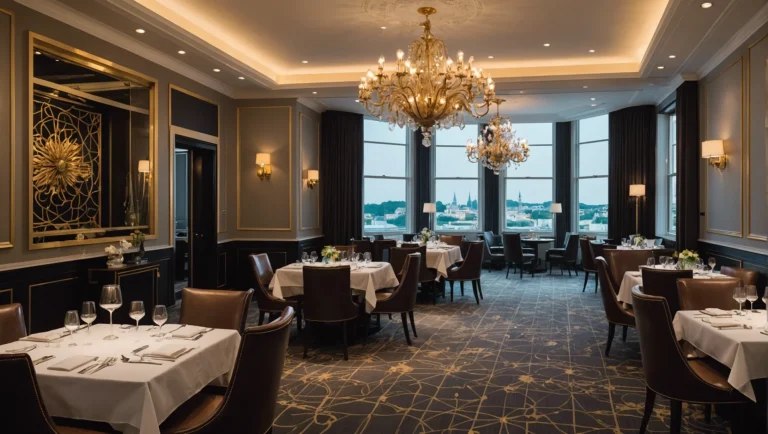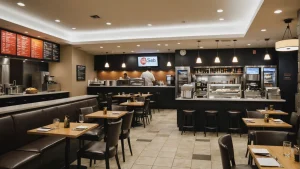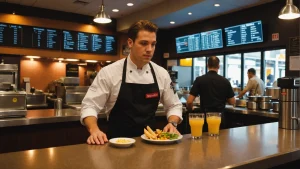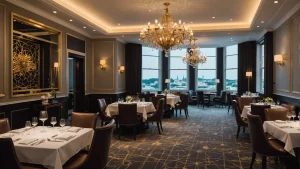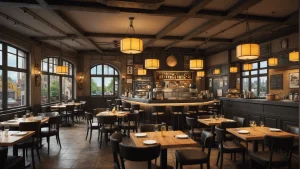What sets a fine dining restaurant apart from the rest? It’s not just about the food; it’s the entire experience. From the moment guests step through the doors, they are transported into a world of elegance, sophistication, and unparalleled service. Delve into the various categories of dining establishments and uncover an ideal venue that cater
But what exactly qualifies as a fine dining restaurant?
In this article, we’ll explore the key elements that define these high-end establishments, from the exquisite cuisine and attentive service to the refined ambiance and attention to detail.

Lower your delivery costs by 23%
How we reduce costs:
- No delivery vehicle expenses
- Optimized local routes
- Pay-per-delivery model
- Average 23% delivery cost reduction
What is a Fine Dining Restaurant?
-
Fine dining restaurants offer high-quality food, exceptional service, and an upscale ambiance.
-
These establishments focus on creating a memorable dining experience for their guests.
Fine dining restaurants are the epitome of luxury and sophistication in the culinary world. These establishments prioritize providing guests with an unforgettable dining experience, combining exceptional food quality, attentive service, and an elegant atmosphere. From the moment you step through the doors, you are transported into a world of refinement and indulgence. Curious about how a different atmosphere offers a distinct experience? Discover the characteristics and operational intricacies of fast casual dining establishments for a contrasting perspective.
At the heart of any fine dining restaurant is the food. Chefs at these establishments are highly skilled and trained, often with years of experience in top kitchens around the world. They use only the finest, freshest ingredients to create dishes that are not only visually stunning but also bursting with flavor. Menus are carefully crafted to showcase the best of what’s in season, with a focus on creativity and innovation.
Types of Fine Dining Restaurants
While all fine dining restaurants share a commitment to excellence, there are different types of establishments within this category.
Traditional Fine Dining
Traditional fine dining restaurants are what most people think of when they hear the term “fine dining.” These establishments have a classic, upscale atmosphere, often with white tablecloths, crystal chandeliers, and formal decor. The dress code is typically formal, with men expected to wear jackets and ties and women in cocktail attire. These restaurants are open in the evening or at night in general.
The menu at a traditional fine dining restaurant is usually multi-course, with options for appetizers, entrees, and desserts. The food is classic and refined, with dishes that are expertly prepared and beautifully presented.
Contemporary Fine Dining
In recent years, there has been a shift towards a more modern and relaxed approach to fine dining. Contemporary fine dining restaurants still prioritize exceptional food and service but with a more casual and approachable atmosphere.
The decor in these restaurants is often sleek and minimalist, with an emphasis on natural materials and clean lines. The dress code is more relaxed, with smart casual attire being the norm.
The menu at a contemporary fine dining restaurant is often more experimental and innovative, with a focus on unique flavor combinations and artistic presentation. Chefs at these establishments are not afraid to push the boundaries and take risks, resulting in dishes that are both surprising and delicious.

Metrobi is transforming food product deliveries
Specialized solutions for food product businesses:
- Food product-trained drivers
- Proper handling equipment
- Peak day delivery support
- 23% average cost reduction
Fine Dining Service Standards
Attentive and Knowledgeable Staff
The foundation of exceptional fine dining service lies in the expertise and attentiveness of the restaurant’s staff. Servers in high-end establishments undergo rigorous training to develop a deep understanding of the menu, including ingredients, preparation methods, and potential allergens. This knowledge allows them to confidently guide guests through the dining experience, offering personalized recommendations based on individual preferences and dietary restrictions.
Moreover, fine dining servers are well-versed in wine pairings, working closely with the sommelier to suggest complementary wines for each course. Their familiarity with the wine list enables them to describe the unique characteristics and origins of each wine, enhancing the overall dining experience. Attentive service also means anticipating guests’ needs before they even ask, such as refilling water glasses, replacing utensils, and offering additional bread or condiments.
Impeccable Table Service
Fine dining restaurants adhere to strict protocols for table settings and service to ensure a flawless and elegant presentation. Each course is accompanied by the appropriate cutlery, glasses, and plates, arranged according to traditional formal dining etiquette. Servers are trained to deliver and clear plates from the correct side, using proper serving trays and techniques to minimize disruption to the table.
The pacing of the meal is carefully orchestrated, with ample time between courses to allow guests to savor each dish and engage in conversation. Servers discreetly monitor the table, clearing plates only when all diners have finished and replacing utensils as needed. They may also offer crumb scraping between courses, using a small tool to remove any stray crumbs from the tablecloth, and maintaining a pristine dining area throughout the meal.
Wine and Beverage Service
An extensive and well-curated wine list is a defining feature of fine dining restaurants. Sommeliers, or wine experts, are on hand to guide guests through the selection process, offering insights into the characteristics, origins, and ideal pairings for each wine. They may present the wine bottle to the host for approval before expertly opening and decanting the wine, if necessary.
Proper wine service also involves presenting the cork for inspection, pouring a small sample for the host to taste and approve, and then carefully filling each guest’s glass. Sommeliers and servers are attentive to refilling glasses throughout the meal, ensuring that guests never have to pour their wine.
In addition to wine, fine dining restaurants offer a range of cocktails and non-alcoholic beverages, often crafted with the same level of expertise and creativity as the food menu. Bartenders are skilled in mixology and can create classic cocktails or unique signature drinks to complement the dining experience. Non-alcoholic options may include artisanal sodas, fresh juices, and premium teas and coffees.
Personalized Attention and Special Requests
Fine dining service is characterized by a high level of personalized attention, with staff going above and beyond to accommodate special requests and preferences. This may include modifying dishes to suit dietary restrictions, preparing off-menu items for regular customers, or arranging special celebrations such as birthdays or anniversaries.
Servers in fine dining restaurants are trained to read guests’ body language and anticipate their needs, ensuring that every aspect of the dining experience is tailored to their comfort and enjoyment. They may offer recommendations based on guests’ stated preferences or previous orders, creating a sense of familiarity and personalized service.
Fine Dining Ambiance and Decor
-
Fine dining restaurants create an elegant atmosphere with tasteful decor, lighting, and table settings
-
Attention to detail in every aspect of the dining room ensures a sophisticated and comfortable experience
-
The ambiance sets the stage for an exceptional meal and memorable dining experience
Elegant and Sophisticated Atmosphere
Fine dining restaurants carefully design their dining rooms to create an elegant and sophisticated atmosphere. The decor is tasteful and upscale, often featuring high-quality materials such as wood, marble, or leather. The lighting is soft and understated, creating a warm and inviting ambiance. Restaurants may use chandeliers, wall sconces, or table lamps to achieve the desired effect.
Seating arrangements in fine dining establishments prioritize comfort and privacy. Tables are well-spaced to allow for intimate conversations and to avoid overcrowding. Chairs are typically plush and comfortable, encouraging diners to linger and enjoy their meal. Some restaurants may feature booths or private dining rooms for added exclusivity.
The Role of Music and Noise Levels
Background music in fine-dining restaurants is carefully selected to complement the overall atmosphere. The music is usually soft and unobtrusive, allowing for easy conversation. Classical, jazz, or instrumental music are popular choices. The volume is kept low to ensure that diners can comfortably talk to one another without having to raise their voices.
Noise levels are also carefully controlled in fine dining establishments. The room’s design, including the use of sound-absorbing materials like carpets and curtains, helps to minimize excessive noise. The staff is trained to speak quietly and to avoid creating unnecessary disturbances, such as loud clanging of dishes or silverware.
Table Settings and Linens
Table settings in fine dining restaurants are elegant and precise. High-quality table linens, such as crisp white tablecloths and cloth napkins, are a standard feature. The linens are often made from premium materials like linen or cotton and are freshly pressed for each service.
The tableware is carefully selected to complement the restaurant’s decor and cuisine. Fine dining establishments typically use high-quality china, glassware, and silverware. The place settings are meticulously arranged, with each item placed in its designated position. The presentation of the table setting is an essential aspect of the fine dining experience.
Centerpieces and Table Decorations
Centerpieces and table decorations are common in fine-dining restaurants. Fresh flowers are a popular choice, adding a touch of elegance and a pleasant aroma to the dining room. Some restaurants may opt for more elaborate centerpieces, such as sculptures or candle arrangements. The table decorations are carefully chosen to enhance the overall ambiance without being overly distracting.
For instance, some fine dining restaurants may use flowers like roses, orchids, or calla lilies, which are known for their elegance and sophistication.
Candles are another common feature in fine dining table settings. The soft, flickering light creates a romantic and intimate atmosphere. Some restaurants may use tea lights or votive candles, while others may opt for taller tapers. The use of candles not only enhances the ambiance but also provides a flattering light for diners.
The concept of a fine dining restaurant revolves around creating an exceptional and memorable dining experience. From the moment guests enter the restaurant, they are immersed in an elegant and sophisticated atmosphere. The attention to detail in every aspect of the dining room, from the decor to the table settings, sets fine dining apart from casual or fast-food establishments.
Fine dining restaurants aim to engage all the senses, not just taste. The visual appeal of the dining room, the soft background music, and the pleasant aromas wafting from the kitchen all contribute to the overall experience. The ambiance is designed to make guests feel special and pampered, allowing them to escape from the stresses of everyday life and enjoy a truly luxurious dining experience.
Michelin Star Restaurant Criteria
-
Michelin stars are awarded to restaurants that excel in cuisine, service, and atmosphere
-
Restaurants can earn one, two, or three stars based on the quality of their offerings
-
Michelin inspectors visit restaurants anonymously to evaluate their experiences
Exceptional Cuisine
The foundation of any Michelin-starred restaurant is its exceptional cuisine. Chefs at these establishments use high-quality ingredients and innovative cooking techniques to create unique and memorable flavor profiles. The execution of each dish is consistent, with meticulous attention to detail ensuring that every plate leaves the kitchen in perfect condition.
Michelin inspectors look for dishes that showcase the chef’s creativity and mastery of their craft. The menu should feature a balance of classic and contemporary dishes, with each item telling a story through its flavors and presentation. The quality of ingredients is paramount, with many Michelin-starred restaurants sourcing from local producers or even growing their produce to ensure freshness and sustainability.
Innovative Cooking Techniques
Michelin-starred chefs are known for their innovative cooking techniques, which often involve the use of modern equipment and methods. For example, sous vide cooking allows chefs to precisely control the temperature of ingredients, resulting in perfectly cooked dishes with enhanced flavors and textures. Molecular gastronomy, a scientific approach to cooking, has also gained popularity in recent years, with chefs using techniques like spherification and foams to create visually striking and flavorful dishes.
Outstanding Service
In addition to exceptional cuisine, Michelin-starred restaurants are known for their outstanding service. From the moment guests arrive, they are greeted by a well-orchestrated team of servers and staff who provide attentive and personalized service throughout the dining experience.
Servers at Michelin-starred restaurants are knowledgeable about the menu and can offer expert recommendations based on guests’ preferences. They are also trained to anticipate guests’ needs, ensuring that every aspect of the dining experience is seamless and enjoyable. The service is never intrusive or overbearing, but rather a subtle and intuitive presence that enhances the overall experience.
Refined Atmosphere
The atmosphere of a Michelin-starred restaurant is an integral part of the dining experience. These establishments typically feature elegant decor and a comfortable dining room that creates a harmonious ambiance to complement the cuisine.
The decor of a Michelin-starred restaurant is often understated and sophisticated, with a focus on quality materials and craftsmanship. The lighting is carefully designed to create a warm and inviting atmosphere, while the table settings and furnishings are chosen to enhance the overall aesthetic.
Immaculate Presentation
Presentation is a key aspect of the Michelin-starred dining experience. Each dish is meticulously plated, with careful attention paid to the arrangement of ingredients and the use of color and texture. The presentation is not only visually appealing but also serves to enhance the flavors and aromas of the dish.
The same level of attention to detail is applied to the presentation of the dining room itself. Tables are immaculately set with crisp linens, gleaming silverware, and polished glassware. The overall effect is one of refinement and sophistication, creating an atmosphere that is both inviting and impressive.
The Fine Dining Experience
Reservations and Arrival
Making a reservation at a fine dining restaurant is often a must, as these establishments tend to have limited seating and high demand. Many fine dining restaurants offer online reservation systems or require a phone call to secure a table. Some restaurants may also offer a coat check service and assist you with seating. Curious about the experience offered by a counter service dining establishment in comparison? Learn more about the convenience and informal atmosphere of dining at a counter service restaurant.
For those considering how to enhance their dining experience even further, utilizing a reliable meal prep delivery service can be a beneficial option. This service not only provides convenience but also ensures that you can enjoy gourmet meals prepared by chefs right at home, perfectly complementing your fine dining experiences.
Menu Presentation and Ordering
Fine dining restaurants often feature carefully curated menus that showcase the chef’s creativity and the restaurant’s culinary philosophy. Upon being seated, guests would typically receive a physical menu or a verbal explanation of the menu concept and any specials available that day.
Accommodating Seasonal Menu or Special Dietary Needs
Fine dining restaurants are usually equipped to handle various dietary restrictions and allergies. When making your reservation, it’s a good idea to inform the restaurant of any specific requirements you may have. This allows the kitchen staff to prepare accordingly and ensures a seamless dining experience. During the ordering process, your server will also confirm any allergies or restrictions to avoid any potential issues.
Pacing and Flow of Courses
One of the hallmarks of a fine dining experience is the well-timed delivery of courses. The kitchen staff and service team work together to ensure that each course is served at the appropriate time, allowing guests to savor each dish without feeling rushed or experiencing long wait times between courses.
The timing of courses in a fine dining setting is carefully orchestrated to allow guests to enjoy each dish at its optimal temperature and freshness. Servers are trained to read the pace of the table and adjust the timing of courses accordingly. They may also offer suggestions on wine pairings or cocktails to complement each course, further elevating the overall dining experience.
Servers will be knowledgeable about the menu, able to answer questions and provide recommendations. They’ll discreetly check on the table of the guests, refill beverages, and ensure that they have everything they need without being intrusive. This level of service is a key aspect of the fine dining experience, as it allows guests to fully immerse themselves in the enjoyment of the meal and the company of their dining companions.
Creating a Fine Dining Restaurant
Developing a Concept and Menu
When creating a fine dining restaurant, it’s essential to identify your target audience and culinary focus. You can consider the demographics of your desired location, such as age, income level, and dining preferences. This information will help you tailor your concept and menu to appeal to your target market.
Once you have a clear understanding of your audience, determine your culinary focus. This could be a specific cuisine, such as French or Italian, meals with steak, or a particular style of dining, like farm-to-table or molecular gastronomy. Your culinary focus should be unique and set you apart from other restaurants in the area.
With your target audience and culinary focus in mind, create a unique and cohesive menu. Your menu should reflect your restaurant’s concept and showcase your chef’s skills and creativity. You can consider offering a mix of classic dishes and innovative creations to keep your menu interesting and appealing.
When designing your menu, pay attention to the balance of flavors, textures, and presentation. Each dish should be carefully crafted to provide a memorable dining experience. Don’t forget to include options for dietary restrictions, such as vegetarian, vegan, and gluten-free dishes.
The quality of your ingredients is crucial to the success of your fine-dining restaurant. You can establish relationships with local farmers, fishmongers, and suppliers to ensure you have access to the freshest, highest-quality ingredients.
You can consider incorporating seasonal and locally sourced ingredients into your menu. This not only supports your local community but also allows you to offer the freshest flavors to your guests. Be transparent about the origin of your ingredients, as many diners appreciate knowing where their food comes from.
Hiring and Training Staff
Building a strong team is essential for creating a successful fine-dining restaurant. Recruit experienced and passionate individuals who share your vision and commitment to excellence. This includes hiring a talented executive chef, skilled sous chefs, knowledgeable servers, and attentive support staff.
When hiring, look for individuals with a proven track record in the fine dining industry. Your executive chef should have experience creating and executing high-end menus, while your servers should have a deep understanding of fine dining service standards and etiquette.
Once you have assembled your team, you should provide comprehensive training to ensure everyone is well-prepared to deliver an exceptional dining experience. This training should cover all aspects of your restaurant, including the menu, service standards, and wine knowledge.
Your staff should be intimately familiar with every dish on your menu, including ingredients, preparation methods, and suggested wine pairings. They should also be trained in proper service etiquette, such as table setting, order taking, and food and wine presentation.
Creating a positive and collaborative work environment is key to the success of your fine dining restaurant. Foster a team-oriented culture where everyone works together to deliver an exceptional guest experience.
Encourage open communication and regular feedback sessions to ensure your staff feels valued and supported. Recognize and reward outstanding performance to keep your team motivated and engaged.
Most importantly, emphasize a guest-centric approach in all aspects of your restaurant. Every team member should be focused on anticipating and exceeding guest expectations, from the moment they enter the restaurant until the moment they leave.
Designing the Dining Room
The design of your dining room plays a significant role in creating the ambiance and atmosphere of your fine dining restaurant. Your goal should be to create an elegant and comfortable space that enhances the overall dining experience.
You can consider the layout of your dining room, ensuring there is ample space between tables for privacy and ease of movement. Pay attention to lighting, using a combination of ambient and task lighting to create a warm and inviting atmosphere.
You should invest in high-quality furnishings and decor that reflect your restaurant’s concept and style. This includes comfortable seating, elegant table settings, and tasteful artwork or decorative elements.
Choose materials that are both visually appealing and durable, as they will need to withstand daily use. You should pay attention to details, such as linens, glassware, and flatware, ensuring they are of the highest quality and contribute to the overall dining experience.
Lighting and acoustics play a crucial role in creating the desired ambiance in your fine dining restaurant. Ensure your lighting is adjustable to accommodate different times of day and occasions, such as a romantic dinner or a business lunch.
Consider the acoustics of your dining room, as well. Proper sound absorption and insulation can help reduce noise levels and create a more intimate and comfortable dining experience. This can be achieved through the use of soft furnishings, such as curtains and upholstered seating, as well as sound-absorbing materials in the ceiling and walls.
Elevating Your Dining Experience
Fine dining restaurants offer an unparalleled culinary journey, combining exceptional cuisine, impeccable service, and a refined ambiance. From the attentive staff to the elegant decor, every aspect contributes to a memorable dining experience. Dive into the variety of dining establishments and select the ideal fine dining restaurant to elevate your dining adventures.
In conjunction with elevating your dining experience, other aspects of convenience play a vital role in enhancing the overall enjoyment. For those who wish to enjoy fine dining at home, exploring a reliable delivery option can be an excellent choice. Discover more about the efficiencies of an exceptional same-day delivery service in New York City that can bring your favorite dishes right to your doorstep.
Before having your own Fine Dining restaurant, consider exploring and searching for a Michelin-starred restaurant or a renowned establishment in your town or located area. Additionally, if you’re planning a special evening and would like to enhance your dining experience, consider utilizing a reliable service for your needs. Explore the benefits of a top-notch Boston same-day delivery service to ensure a seamless evening, whether it’s for bringing in a special bottle of wine or gourmet treats.
If you’re looking for a convenient way to enjoy exceptional dining experiences at home, consider utilizing Metrobi’s reliable same-day courier service in Los Angeles. This service ensures that your favorite dishes arrive fresh and on time, allowing you to indulge in gourmet meals without the hassle of dining out. Explore the benefits of a top-notch Los Angeles same-day courier service that can enhance your culinary adventures.

